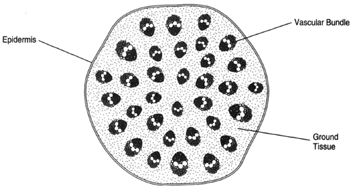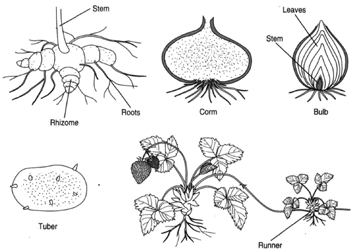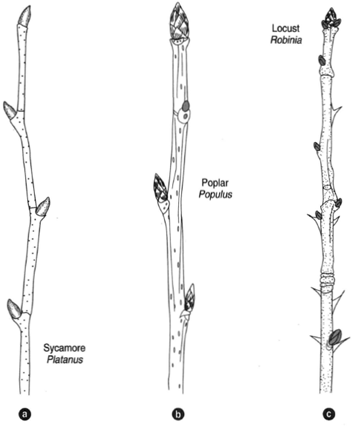The Monocot Stem
Monocots are mostly annuals, meaning they live for only a single season.
They are most readily recognized by their leaves: although there are exceptions,
most monocot leaves exhibit
parallel venation. A cross section of a
monocot stem (figure 32-13) shows vascular bundles scattered in parenchyma.
There may be a layer of sclerenchyma beneath the epidermis.
Although this arrangement of vascular bundles represents the simplest
organization of stem structures, it is believed to have evolved comparatively
recently. Examination of the xylem portion of the vascular bundle reveals two
(or perhaps three) large vessels surrounded by small, thick-walled tracheids,
see figure 32-14. In addition to the vessels, there is commonly another open
space sometimes mistaken for a vessel but lacking a cell wall. This space is
produced by a fracture: it isn ot a cell and is not involved in conduction. The
phloem portion of the bundle shows sieve-tube elements with companion
cells beside them. The entire bundle is surrounded by a bundle sheath of
sclerenchyma. Outside the sheath is the parenchyma, consisting of large,
thin-walled cells.
 |
| Figure 32-13 Cross section of a monocot stem. |
 |
| Figure 32-14 Much enlarged portion of a monocot vascular bundle. (a) Sieve cell.
(b) Xylem vessel. (c) Tracheid. (d) Parenchyma. (e) Fractured open space. |
Modified Stems
Several examples of modified stems are shown in figure 32-15.
Stolons are
horizontal stems that grow above ground and develop new plantlets at the tips
wherever the stems touch the ground. New shoots and roots are formed at
nodes. Strawberry plants are an example of stolons.
Rhizomes are horizontal
stems that grow underground. They also produce new shoots and roots at the
nodes. Lawn grasses and blueberry plants possess rhizomes.
Bulbs,
corms,
and
tubers are short, underground stems that take part in vegetative propagation.
An example of a bulb is an onion. A bulb is a small mound of stem
bearing overlapping fleshy leaves that store reserves of starch and sugar. The
leaves are called bulb scales. Small bulbs may develop in the axils at the base
of the bulb. A corm takes the form of a squatty, swollen stem. It lacks scalelike
leaves. New, small corms originate from buds at the nodes. These small
corms can be separated and planted. Examples of corms are gladiolus and
crocus. Tubers are the expanded tips of rhizomes. The Irish potato (
Solanum
tubemurn) is the best known example. One can plant whole tubers or cut
sections bearing one or more nodes. It is recommended that cut sections be
allowed to dry for severald ays prior to planting in order to discourage decay.
A thorn is a modification of a stem. Thorns are present on honey locusts
and hawthorns. Many kinds of plants produce climbing stems, which crawl
over rocks or other stems. They are called vines or, if woody, lianas.
Many vines and lianas have twining stems. The twining stems of some
species turn clockwise, some counterclockwise, and some in both directions.
Stem tips tend to turn in a spiral because of growth inequalities. This
phenomenon is called nutation. When the young stem touches some
surface, twining increases. The cells on the side of the stem that touches
an object shorten, and the cells on the opposite side grow longer. The end
result is a curving of the stem tip. Many vines have tendrils, which tend, to grasp any touched surface. Grape vines have tendrils opposite each leaf.
The tendrils of Boston ivy have adhesive discs, which enable it to adhere
to stone walls. Poison ivy produces adventitious roots, which function in
the same way.
 |
| Figure 32-15 Modified stems. |
 |
| Figure 32-16 (a) Stem of the sycamore, Platanus. The buds are enclosed n the dilated
bases of petioles. (b) Stem of the poplar, Populus. The scaly buds shown here are
frequently covered with a resinous varnish. (c) Stem of the locust tree, Robinia. It exhibits
spinous stipules, which are paired appendages occurring at the bases of leaves. Bud
characteristics are of frequent value in taxonomic work. |
A plant called “butcher’s broom” produces flattened, leaflike stems
called
cladophylls. In the center of each cladophyll is a node bearing a scalelike leaf (figure 32-17). The feathery appearance of asparagus is caused by
cladophylls.
 |
| Figure 32-17 (a) The cactus Opuntia, bearing cladophylls. (b) Butcher’s broom. The
flattened, leaflike structure is a modified stem called a cladophyll. Cladophylls are stems
that assume the properties and functions of leaves. |









